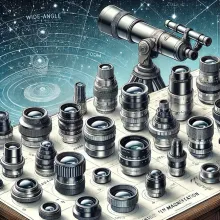
Huyghens Telescope Eyepieces

Huygens eyepieces are a classic type of optical design primarily used in telescopes and microscopes. Developed by Christiaan Huygens in the 17th century, they consist of two plano-convex lenses separated by a small air gap. The design is simple and effective for low to medium magnifications. Huygens eyepieces are characterized by having a narrow field of view (approximately 30° to 40°) and are best suited for long focal length instruments. Although they produce some chromatic and spherical aberrations, they are still widely used in entry-level telescopes due to their affordability and historical significance in optical design.
Kellner Telescope Eyepieces

About 150 years later in 1849 Carl Kellner created the first achromatic eyepiece using special glasses. This was a vast improve reducing aberrations and also had good color correction. The only problem was this eyepiece had internal reflections. Today modern coatings are applied to eliminate reflections making this a fair inexpensive eyepiece.
Orthoscopic Telescope Eyepieces
(A planetary eyepiece)

The next innovation came about 30 years later in 1880 by Ernst Abbe. With good color correction, minimal spherical aberration, good contrast, and a flat field of view these have been one of the most popular eyepieces for more than 100 years. With newer wider field eyepieces developed in recent years this eyepiece is not quite as popular. Since contrast and color are more important than field of view when viewing planets, this is still a popular planetary eyepiece. This is one of my favorite eyepieces for viewing planets.
Plossl Telescope Eyepieces
(A versatile eyepiece)

Developed in 1860 by an Austrian optician named G.S. Plossl, it was nearly 100 years before this eyepiece became popular. These are expensive to make and therefore cost more than an ortho. These eyepieces have great eye relief, field of view, and contrast making them a ideal for all observing targets. more...
Erfle Telescope Eyepieces

Erfle eyepieces are a type of wide-angle eyepiece design originally developed by Heinrich Erfle in the early 20th century. They are known for their relatively large field of view, typically ranging from 55 to 65 degrees, making them ideal for deep-sky observations and wide-field astronomical viewing. Erfle eyepieces feature a 5- or 6-element configuration that includes at least one achromatic doublet, providing a balance between image quality and field of view.
Although Erfle eyepieces offer excellent clarity and contrast in the center of the field, they tend to show edge distortion and chromatic aberration at the periphery, especially when used in telescopes with shorter focal ratios. Due to these limitations, they are more commonly used in longer focal length telescopes, where the aberrations are minimized.
Today, Erfle designs have largely been supplanted by more modern eyepiece technologies such as the Nagler and Ethos lines, which provide wider fields of view and better edge correction. However, Erfle eyepieces are still valued by amateur astronomers for their affordability and performance in less demanding observing scenarios. more...
Super Wide Telescope Eyepieces
These modern eyepieces have a field of view from 65-70 degrees. With the creation of the Televue Panoptic by Al Nagler a revolution in eyepiece design was spawned. The competition is fierce which is great for eyepiece consumers. These eyepieces are great for viewing large nebulae and star clusters. more...
Ultra-Wide Telescope Eyepieces
With field of view of 80 degrees and greater, these eyepieces have become very popular with astronomers will to lay out the big sums of money. While these are great for many objects, a simpler design may give a better view of small bright objects like planets. more...
Barlow Lenses for Telescopes
While not actually an eyepiece, a barlow is attached to an eyepiece that magnifies the image. Barlows are purchased by magnification power (1.5x, 2x, 4x...) Barlows are mainly used for planetary or binary star viewing since they can reduce the amount of light passing through. They are also a way to get high magnification and good eye relief at the same time. more...
Zoom Telescope Eyepieces
Zoom eyepieces are very handy since as their name implies the magnification factor can be adjusted. While this makes them useful, a good quality zoom is very expensive and still not as good as having several eyepieces of varying magnification. more...
Bino Viewer Telescope Eyepieces
Bino viewers are devices that allow you to use both of your eyes to view the image in a telescope. The results are truly dramatic. Images have an almost 3-dimensional look. When you use both eyes you are also using both sides of you brain.
The thing to keep in mind about Bino viewers is that you need two of each eyepiece. This can become very expensive. more...
